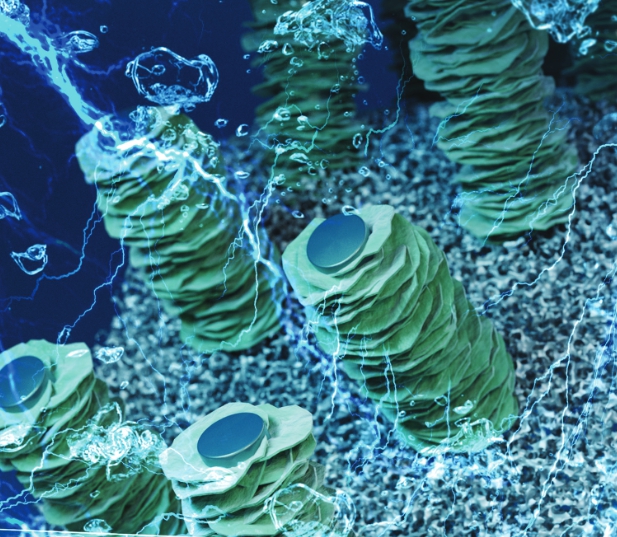| 일 | 월 | 화 | 수 | 목 | 금 | 토 |
|---|---|---|---|---|---|---|
| 1 | 2 | 3 | 4 | |||
| 5 | 6 | 7 | 8 | 9 | 10 | 11 |
| 12 | 13 | 14 | 15 | 16 | 17 | 18 |
| 19 | 20 | 21 | 22 | 23 | 24 | 25 |
| 26 | 27 | 28 | 29 | 30 | 31 |
Tags
- nanotechnology
- LSPR
- 초대장
- Chemistry
- DNA nanostructures
- citation
- soft lithography
- Materials Science
- Multidisciplinary
- Impact Factor 2011
- Physics
- Journal Impact Factor 2010
- 2011 Journal Impact Factor
- Impact Factor
- Analytical Chemistry
- 티스토리 초대장
- 티스토리 초대권
- Nanoparticle
- 나노기술
- DNA nanotechnology
- Impact Factor 2009
- Journal Impact Factor
- Nano Research Group
- localized surface plasmon resonance
- Journal Impact Factor 2009
- Nanoscience
- nanowires
- plasmonics
- Post Doctor
- DNA origami
Archives
- Today
- Total
Amazing Nanotechnology
Science as Art! 본문
과학은 예술이다. 과학은 아름답다.
아래 이미지들을 보면, 이 말이 과히 과장된 말이 아님을 알 수 있다. 우리가 쉽게 접할 수 있는 거시 세계의 과학기술, 아름답고 웅장한 건축물 같은 것도 인류의 문화의 소중한 자산이자 예술 그 자체 이지만, 미시 세계의 과학기술 또한 그에 못지 않다. 현재에는 아주 다양한 마이크로 및 나노 세계를 이미징하는 테크닉이 발달되어 있어서, 다양한 나노물질부터 시작해서 생체세포까지 모두 일반사진기처럼 찍어서 볼 수가 있다. 물론 그 과정이 쉽지만은 않지만 말이다.
많은 과학기술관련 학회에서 주최하는 conference에서는 imaging contest를 연다. 특히 바이오 관련 학회나 재료관련 학회에서 많은 편이다. 아래 사진들은 재료관련 학회에서는 세계에서 가장 큰 미국의 Materials Research Society (MRS)에서 매년 마다 여는 science as art competition에서 수상한 작품(?)들이다. 좀 더 화려하게 보이기 위해서 포토샵으로 색깔을 덫칠하기도 하지만, 그 자체만으로도 아름답다고 할 수 있다. 감상들 해보시길.

 2008 MRS Fall Meeting, 2nd Place Winner
2008 MRS Fall Meeting, 2nd Place Winner
by Matthew J. Bierman, University of Wisconsin-Madison
"Two Pine Trees"
 2007 MRS Spring Meeting, 1st Place Winner
2007 MRS Spring Meeting, 1st Place Winner
by Joel Henzie, Northwestern University
"Gold Nanopyramids"
 2007 MRS Spring Meeting, 1st Place Winner
2007 MRS Spring Meeting, 1st Place Winner
by Matthew Lloyd, Cornell University
"Sunflowers"
A Bouquet of Anthradithiophene
아래 이미지들을 보면, 이 말이 과히 과장된 말이 아님을 알 수 있다. 우리가 쉽게 접할 수 있는 거시 세계의 과학기술, 아름답고 웅장한 건축물 같은 것도 인류의 문화의 소중한 자산이자 예술 그 자체 이지만, 미시 세계의 과학기술 또한 그에 못지 않다. 현재에는 아주 다양한 마이크로 및 나노 세계를 이미징하는 테크닉이 발달되어 있어서, 다양한 나노물질부터 시작해서 생체세포까지 모두 일반사진기처럼 찍어서 볼 수가 있다. 물론 그 과정이 쉽지만은 않지만 말이다.
많은 과학기술관련 학회에서 주최하는 conference에서는 imaging contest를 연다. 특히 바이오 관련 학회나 재료관련 학회에서 많은 편이다. 아래 사진들은 재료관련 학회에서는 세계에서 가장 큰 미국의 Materials Research Society (MRS)에서 매년 마다 여는 science as art competition에서 수상한 작품(?)들이다. 좀 더 화려하게 보이기 위해서 포토샵으로 색깔을 덫칠하기도 하지만, 그 자체만으로도 아름답다고 할 수 있다. 감상들 해보시길.

2008 MRS Fall Meeting, 1st Place Winner
by PaiChun Wei, National Taiwan University
"Nanoflower"
by PaiChun Wei, National Taiwan University
"Nanoflower"
The crystalline wurtzite indium nitride (InN) nanoflower was synthesized via molecular beam epitaxy (MBE) processes, using pure indium and a high efficient nitrogen source, hydrazoic acid (HN3). (Center for Condensed Matter Science, National Taiwan University, Taipei, Taiwan.)

by Matthew J. Bierman, University of Wisconsin-Madison
"Two Pine Trees"
These pine tree lead sulfide nanowires obtain a complicated structure because only the trunk contains a screw dislocation that causes it to twist.

by Joel Henzie, Northwestern University
"Gold Nanopyramids"
High resolution scanning electron micrograph (SEM) of gold nanopyramids supported by silicon pedestals. The orientation-dependent optical properties of the nanoparticle arrays have revealed new insight into the interaction between light and materials at the nanoscale. These structures are also being explored in applications such as chemical and biological sensing and nanophotonics. Joel Henzie developed the large-area nanofabrication techniques to create the pyramids while working in the Odom lab at Northwestern University.

by Matthew Lloyd, Cornell University
"Sunflowers"
A Bouquet of Anthradithiophene
